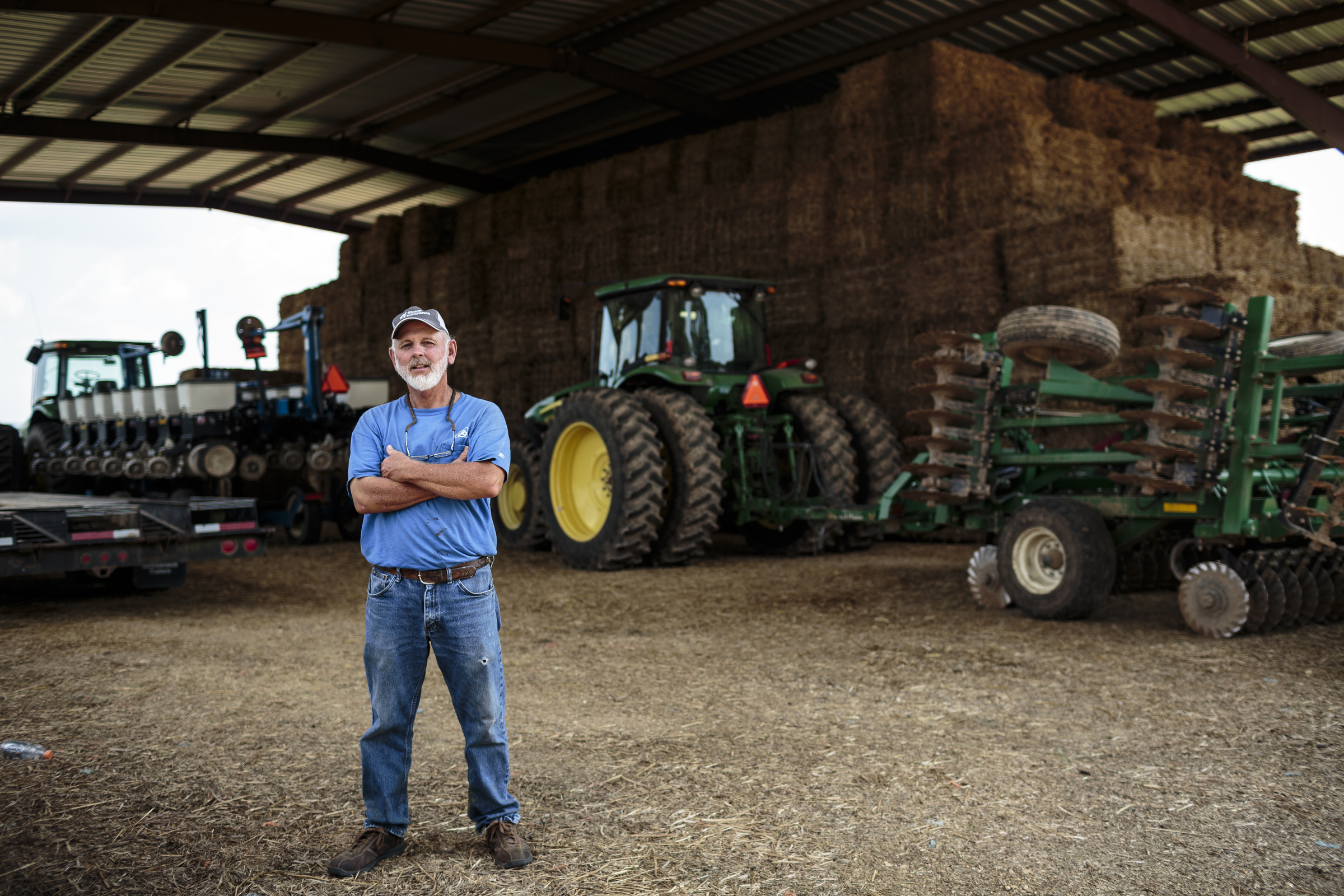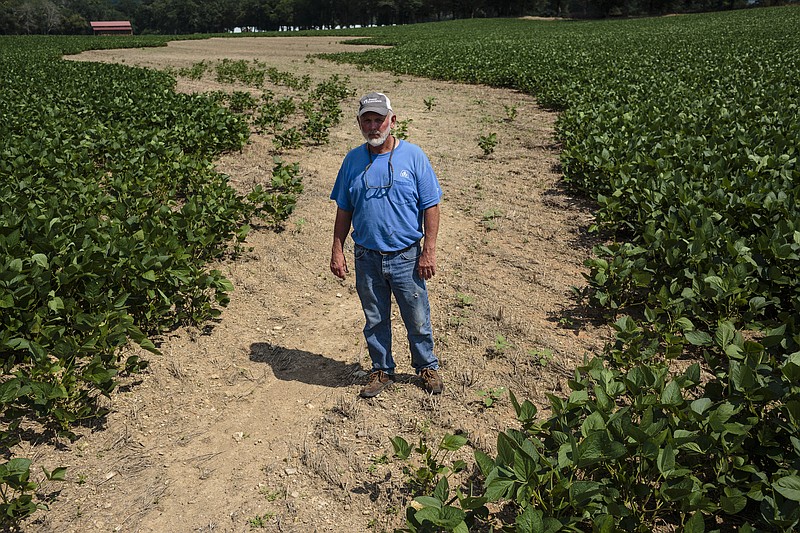 Staff photo by Doug Strickland / Alan Scoggins stands near a stack of straw, which they alternate growing with soybeans, on the Scoggins family farm on Friday, July 21, 2017, in LaFayette, Ga. Last year, the farm's yield was badly impacted by an exceptionally dry summer, and this year's wet weather has also effected the amount of soybeans they could plant.
Staff photo by Doug Strickland / Alan Scoggins stands near a stack of straw, which they alternate growing with soybeans, on the Scoggins family farm on Friday, July 21, 2017, in LaFayette, Ga. Last year, the farm's yield was badly impacted by an exceptionally dry summer, and this year's wet weather has also effected the amount of soybeans they could plant.In June, Sonny Scoggins saw something he would never have dreamed he'd see - catfish 3 feet long wiggling and flopping among his budding soybean plants.
A storm had passed through his Walker County farm near LaFayette, Ga. The rain was so heavy that a pond overflowed, sending water spilling shin-high streams through the row crops. Over a few days temperatures rose and the water evaporated. The catfish retreated. Then another heavy storm hit, and the whole thing happened again, Scoggins told Times Free Press reporter Tyler Jett.
But what's most unfortunate is that he - and we - can count on it happening again, along with intermittent droughts like we saw in this region last year. Likewise, we can count on more deadly and devastating wildfires like the ones that scorched Gatlinburg and parts of Walden's Ridge last summer and fall.
What we're seeing is just the beginning of the local impacts coming from global warming - or in the more politically correct parlance: climate change. Or as our vacuous president and the Cabinet he surrounds himself with call it: a hoax.
About the same time that first big rain hit the Scoggins farm, Energy Secretary Rick Perry told CNBC he does not believe carbon dioxide emissions from human activity are the main driver of climate change. Rather than CO2, he thinks that "most likely the primary control knob is the ocean waters and this environment that we live in."
Earlier this month, a 2,300-square-mile iceberg about the size of Delaware (let's bring this home: it was the size of the southeastern corner of Tennessee) - broke away to float free in the ocean. That would be an ice cube the size of Hamilton, Marion, Sequatchie, Grundy, Bradley and Polk counties.
Who knows what August will bring.
But a team of climate scientists are trying to give us a heads up about long-term consequences. Their study, published recently in Science Magazine, provides estimates of how global warming could impact the local economy in every county.
There will be winners and losers, and - not surprisingly - the already sweltering South may be a most-affected loser.
According to the study, counties in the Times Free Press delivery area would see damages to the tune of 7.8 percent of their economies.
Let that sink in.
The projected economic loss - as a percentage of 2012's average income - to Hamilton County by 2080 is estimated at 6.74 percent.
And Hamilton, like Franklin, Sequatchie and Bradley counties, is at the low end of the losses scale.
Harder hit will be Walker County in Georgia and Grundy County in Tennessee at 11.04 percent and 10.9 percent, respectively. In between, with losses ranging from just over 9 percent to just under 7 percent are Gordon, Chattooga, Catoosa, Whitfield, Murray and Dade counties in Georgia, as well as Bledsoe, Marion, Rhea, Meigs, McMinn and Coffee counties in Tennessee, along with DeKalb and Jackson counties in Alabama.
Nationally, the losses figure is 4.6 percent.
The things we take for granted that the study finds likely to change the most besides our ability to grow crops? Energy expenses and mortality rates. The study also anticipates changes in the labor forces that would be available under extremely hot weather, as well as crime rates.
Amir Jina, an assistant professor at the University of Chicago and one of the study researchers, said pointedly:
"Our research can't answer this next question, but it is worth considering: Where do people and businesses in the most affected parts of Georgia [and Tennessee and Alabama] go? How will they invest to reduce the impacts?"
In Walker County where the Scoggins brothers farm, the average grower plants 875 acres of corn, 1,475 acres of wheat and 1,450 acres of soybeans in summers that have 10 to 20 days when temperatures spike above 95 degrees. But 44 climate models indicate there will be 75 to 100 of those steep high-temperature days annually by the end of the decade. The corn crop temperature tipping point for damage is 95 degrees; soybeans suffer and show damage in temps above 86 degrees.
"Many places in the South are quite close to this and other thresholds," Jina said. "So as the temperature warms, even a little, Georgia [and the region] starts to see damages."
It's important to note, of course, that these farmers feed us.
So even as the more urban counties like Hamilton see lower incomes and we and our children and grandchildren see higher energy costs (estimated to rise more than 11.5 percent), we'll also be looking at higher food costs as crops fail and change in the heat and uneven rainfalls predicted.
Can we afford to let Trump grandstand and demean investigators who are trying to protect our votes from Russian meddling while he and his dunce Cabinet yawn at climate change?
Can we afford to let Sen. Lamar Alexander or any other politician throw wrenches into any effort to expand alternative energy efforts like wind and solar power?
You may think climate change is a hoax if you like, but catfish in a soybean field and summers with months rather than weeks of 95-plus-degree days are not.
